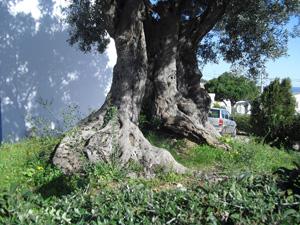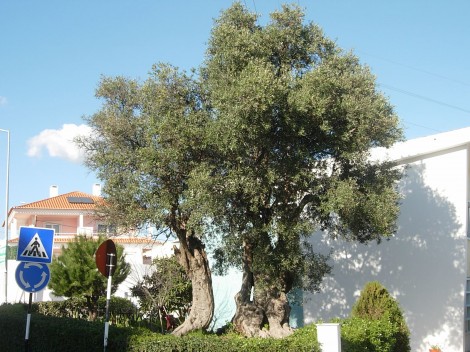(Português) Árvore mais antiga de Portugal tem 2850 anos
ORIGINAL LANGUAGES, 10 Oct 2016
Sofia Marques Correia | Noctula Channel – TRANSCEND Media Service
httpv://www.youtube.com/watch?v=_MDonHyvvgs
A árvore mais antiga que se conhece em Portugal é uma oliveira com 2850 anos. Localiza-se em Santa Iria de Azóia (Loures) e chama-se “Portugal”. Tem 10 metros e 15 centímetros de diâmetro e, apesar da idade, ainda dá azeitonas!
Segundo a Autoridade Florestal Nacional, a árvore mais antiga de Portugal é uma oliveira do concelho de Loures, contemporânea da civilização romana: para abraçar o seu tronco são necessários cinco homens. Antigamente, até meados do século XX, existia ali um grande olival, agora resta apenas uma.
O método de datação foi desenvolvido pela Universidade de Trás-os-Montes e Alto Douro (UTAD), em parceria com a empresa Oliveiras Milenares, e tem como mentores os investigadores do departamento de Ciências Florestais e Arquitetura Paisagista José Luís Louzada e Pacheco Marques.
Para determinar a idade é analisado o diâmetro ou o perímetro do tronco, estudam-se ainda outras árvores, com características idênticas, para depois, de forma comparativa, se ir preenchendo a parte interior como se fosse um puzzle.
Este método não provoca a destruição da árvore, pois não obriga ao seu abate, nem provoca lesões que comprometam a sua saúde. E permite estimar a idade de qualquer árvore muito idosa, podendo ir até aos três mil anos, mesmo que esta se apresente oca no seu interior.
Portugal, em matéria de recordes, orgulha-se de ter a azinheira com maior projeção de copa da Europa, em Lugar das Matas, Santarém, e o carvalho mais antigo da Península Ibérica em Calvos, Braga, que tem 500 anos.
Tem ainda o eucalipto mais alto da Europa, com 72 metros, na Mata Nacional de Vale de Canas, Coimbra, que sobreviveu ao grande incêndio de 2005.
A classificação, restrita a espécies do Continente, é feita pela Autoridade Florestal Nacional (AFN) com base na longevidade, no porte, no desenho e na raridade das árvores, mas também em motivos históricos e culturais.
Go to Original – noctulachannel.com
DISCLAIMER: The statements, views and opinions expressed in pieces republished here are solely those of the authors and do not necessarily represent those of TMS. In accordance with title 17 U.S.C. section 107, this material is distributed without profit to those who have expressed a prior interest in receiving the included information for research and educational purposes. TMS has no affiliation whatsoever with the originator of this article nor is TMS endorsed or sponsored by the originator. “GO TO ORIGINAL” links are provided as a convenience to our readers and allow for verification of authenticity. However, as originating pages are often updated by their originating host sites, the versions posted may not match the versions our readers view when clicking the “GO TO ORIGINAL” links. This site contains copyrighted material the use of which has not always been specifically authorized by the copyright owner. We are making such material available in our efforts to advance understanding of environmental, political, human rights, economic, democracy, scientific, and social justice issues, etc. We believe this constitutes a ‘fair use’ of any such copyrighted material as provided for in section 107 of the US Copyright Law. In accordance with Title 17 U.S.C. Section 107, the material on this site is distributed without profit to those who have expressed a prior interest in receiving the included information for research and educational purposes. For more information go to: http://www.law.cornell.edu/uscode/17/107.shtml. If you wish to use copyrighted material from this site for purposes of your own that go beyond ‘fair use’, you must obtain permission from the copyright owner.
Read more
Click here to go to the current weekly digest or pick another article:
ORIGINAL LANGUAGES:

